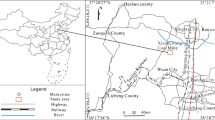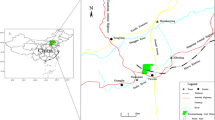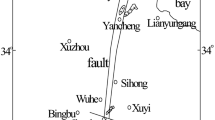Abstract
This paper presents an investigation on source identification of mine water inrush using a geochemical technique. The hydrogeochemistry characteristics can reflect water–rock interaction processes; therefore, the results of hydrochemical analysis could indicate the groundwater occurrence. Although hydrochemical analysis has been reviewed in previous studies, the selection of the evaluation index and the choice of units have seldom been studied. Statistical methods, hierarchical cluster analysis (HCA) and principal component analysis (PCA), were used for analysis by SPSS 21.0. Piper, Durov, and Stiff diagrams were used to identify the four types of water sources. Four types of water samples were used to perform this research, and the major purpose of the present research is to examine the results obtained under different conditions. The results show that the situations arising from the selection of different identification indices, units, and identification methods can lead to great differences. The results are as follows: The selection of trace ions for identification indices can largely affect the discriminant results. In this study, identification results with fewer indicators are poor than results with more indicators as a whole. The unit milliequivalents per liter (mEq/L) is not useful for better identification results according to this study. The data is appropriate for PCA (the Kaiser–Meyer–Olkin measure of sampling adequacy is > 0.5, and the significance value for Bartlett’s test is < 0.01), but its application to reduce dimensions cannot work under all conditions.



Similar content being viewed by others
References
Aravena R, Evans ML, Cherry JA (1993) Stable isotopes of oxygen and nitrogen in source identification of nitrate from septic systems. Groundwater 31(2):180–186. https://doi.org/10.1111/j.1745-6584.1993.tb01809.x
Armengol S, Manzano M, Bea SA, Martínez S (2017) Identifying and quantifying geochemical and mixing processes in the Matanza-Riachuelo Aquifer System, Argentina. Sci Total Environ 599–600:1417–1432. https://doi.org/10.1016/j.scitotenv.2017.05.046
Cetin M (2016) A change in the amount of CO2 at the center of the examination halls: case study of Turkey. Studies on Ethno-Medicine 10(2):146–155
Cetin M, Sevik H, Saat A (2017) Indoor air quality: the samples of Safranbolu Bulak Mencilis Cave. Fresenius Environ Bull 26(10):5965–5970
Datta B, Chakrabarty D, Dhar A (2011) Identification of unknown groundwater pollution sources using classical optimization with linked simulation. J Hydro Environ Res 5(1):25–36. https://doi.org/10.1016/j.jher.2010.08.004
Dinka MO, Loiskandl W, Ndambuki JM (2015) Hydrochemical characterization of various surface water and groundwater resources available in Matahara areas, Fantalle Woreda of Oromiya region. J Hydrol: Reg Stud 3:444–456
Frape SK, Fritz P, McNutt RH (1984) Water-rock interaction and chemistry of groundwaters from the Canadian Shield. Geochim Cosmochim Acta 48(8):1617–1627. https://doi.org/10.1016/0016-7037(84)90331-4
Ghesquière O, Walter J, Chesnaux R, Rouleau A (2015) Scenarios of groundwater chemical evolution in a region of the Canadian Shield based on multivariate statistical analysis. J Hydrol 4:246–266. https://doi.org/10.1016/j.ejrh.2015.06.004
Howladar MF (2017) An assessment of surface water chemistry with its possible sources of pollution around the Barapukuria Thermal Power Plant impacted area, Dinajpur, Bangladesh. Groundwater Sustain Dev 5:38–48. https://doi.org/10.1016/j.gsd.2017.03.004
Huang PH, Wang XY, Han SM (2017) Recognition model of groundwater inrush source of coal mine: a case study on Jiaozuo coal mine in China. Arab J Geosci 10(15):323. https://doi.org/10.1007/s12517-017-3099-5
Ji XL, Xie RT, Hao Y, Lu J (2017) Quantitative identification of nitrate pollution sources and uncertainty analysis based on dual isotope approach in an agricultural watershed. Environ Pollut 229:586–594. https://doi.org/10.1016/j.envpol.2017.06.100
Li PY, Wu JH, Qian H, Lyu X, Liu H (2014) Origin and assessment of groundwater pollution and associated health risk: a case study in an industrial park, Northwest China. Environ Geochem Health 36(4):1–20. https://doi.org/10.1007/s10653-013-9590-3
Lu JT, Li XB, Gong FQ et al (2012) Recognizing of mine water inrush sources based on principal components analysis and fisher discrimination analysis method (in Chinese). China Safety Sci J 22(7):109–115
Meng ZP, Li GQ, Xie XT (2012) A geological assessment method of floor water inrush risk and its application. Eng Geol 143–144:51–60. https://doi.org/10.1016/j.enggeo.2012.06.004
Oh S, Hildreth AJ (2016) Pattern-based energy consumption analysis by chaining principle component analysis and logistic regression. In: Oh S, Hildreth AJ (eds) Analytics for smart energy management: tools and applications for sustainable manufacturing. Springer International, Cham, pp 137–177
Piper AM (1944) A graphic procedure in the geochemical interpretation of water-analyses. Eos Transactions American Geophysical Union 25(6):27–39
Purushotham D, Prakash MR, Rao AN (2011) Groundwater depletion and quality deterioration due to environmental impacts in Maheshwaram watershed of R.R. district, AP (India). Environ Earth Sci 62(8):1707–1721. https://doi.org/10.1007/s12665-010-0666-4
Sevik H, Ahmaida EA, Cetin M (2017) Chapter 31: Change of the air quality in the urban open and green spaces: Kastamonu sample. In: Koleva I, Yuksel UD, Benaabidate L (eds) Ecology, planning and design. St. Kliment Ohridski University Press, ISBN: 978-954-07-4270-0, pp 409–422
Singh A, Sharma CS, Jeyaseelan AT, Chowdary VM (2015) Spatio-temporal analysis of groundwater resources in Jalandhar District of Punjab State, India. Sustain Water Resour Manage 1(3):293–304. https://doi.org/10.1007/s40899-015-0022-7
Stiff JR (1951) The interpretation of chemical water analysis by means of patterns. J Petrol Technol 3(1951):15–17. https://doi.org/10.2118/951376-G
Tallini M, Adinolfi Falcone R, Carucci V, Falgiani A, Parisse B, Petitta M (2014) Isotope hydrology and geochemical modeling: new insights into the recharge processes and water-rock interactions of a fissured carbonate aquifer (Gran Sasso, Central Italy). Environ Earth Sci 72(12):4957–4971. https://doi.org/10.1007/s12665-014-3364-9
Telci IT, Aral MM (2011) Contaminant source location identification in river networks using water quality monitoring systems for exposure analysis. Water Qual, Expo Health 2(3):205–218. https://doi.org/10.1007/s12403-011-0039-6
Tripathy DP, Ala CK (2018) Identification of safety hazards in Indian underground coal mines. Journal of Sustainable Mining 17(4):175–183. https://doi.org/10.1016/j.jsm.2018.07.005
Verma JP (2013) Application of factor analysis: to study the factor structure among variables. In: Verma JP (ed) Data analysis in management with SPSS software. Springer Berlin, Germany, pp 359–387
Wang XY, Ji HY, Wang Q, Liu X, Huang D, Yao X, Chen G (2016) Divisions based on groundwater chemical characteristics and discrimination of water inrush sources in the Pingdingshan coalfield. Environ Earth Sci 75:872. https://doi.org/10.1007/s12665-016-5616-3
Wen T, Zhang B, Shao L (2014) Research on prediction of mine water inrush source identification——Xinzhuangzi coalfield as an example. China Saf Sci J 24(2):100–106 (in Chinese)
Wolkersdorfer C (2008) Hydrogeochemistry of mine water. Water management at abandoned flooded underground mines: fundamentals, tracer tests, modelling, water treatment. Springer Berlin Heidelberg, Berlin, pp 9–36
Wu Q, Mu WP, Xing Y, Qian C, Shen J, Wang Y, Zhao D (2017) Source discrimination of mine water inrush using multiple methods: a case study from the Beiyangzhuang Mine, Northern China. Bull Eng Geol Environ 1–14 https://doi.org/10.1007/s10064-017-1194-1
Yang QC, Li ZJ, Ma HY, Wang L, Martín JD (2016a) Identification of the hydrogeochemical processes and assessment of groundwater quality using classic integrated geochemical methods in the southeastern part of Ordos Basin, China. Environ Pollut 218:879–888. https://doi.org/10.1016/j.envpol.2016.08.017
Yang QC, Wang LC, Ma HY, Yu K, Martín JD (2016b) Hydrochemical characterization and pollution sources identification of groundwater in Salawusu aquifer system of Ordos Basin, China. Environ Pollut 216:340–349. https://doi.org/10.1016/j.envpol.2016.05.076
Zhang Y, Guo F, Meng W, Wang XQ (2009) Water quality assessment and source identification of Daliao River basin using multivariate statistical methods. Environ Monit Assess 152:105–121. https://doi.org/10.1007/s10661-008-0300-z
Zhang B, Song XF, Zhang YH, Han D, Tang C, Yu Y, Ma Y (2012) Hydrochemical characteristics and water quality assessment of surface water and groundwater in Songnen Plain, Northeast China. Water Res 46(8):2737–2748. https://doi.org/10.1016/j.watres.2012.02.033
Zhou J, Shi XZ, Wang HY (2010) Water-bursting source determination of mine based on distance discriminant analysis model. J China Coal Soc 35(2):278–282 (in Chinese)
Acknowledgments
The authors thank the editors and the two anonymous reviewers for their careful work and thoughtful suggestions.
Funding
We gratefully acknowledge the financial support of the National Natural Science Foundation of China (41572244) and the Taishan Scholars Construction Projects.
Author information
Authors and Affiliations
Corresponding author
Rights and permissions
About this article
Cite this article
Wang, D., Shi, L. Source identification of mine water inrush: a discussion on the application of hydrochemical method. Arab J Geosci 12, 58 (2019). https://doi.org/10.1007/s12517-018-4076-3
Received:
Accepted:
Published:
DOI: https://doi.org/10.1007/s12517-018-4076-3




